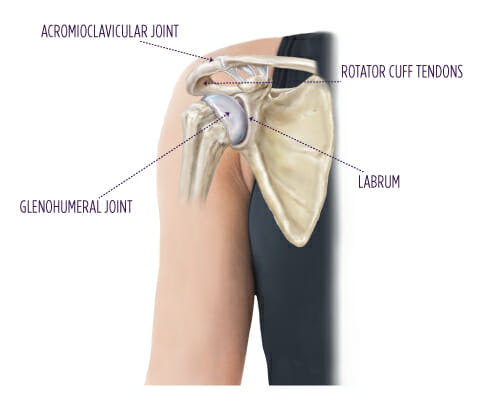Shoulder anatomy is both unique and complex. The shoulder is a unique and complex joint. The shoulder needs a high degree of flexibility, but it also needs to remain stable in multiple planes of motion. To accomplish this, the shoulder joint is supported by a combination of bones, ligaments, and muscles.
The shoulder is made up of the following parts:
- Acromioclavicular (AC) joint – where the collarbone (clavicle) meets the top of the shoulder (acromion).
- Glenohumeral joint – where the head of the upper arm bone. (humerus) and the shoulder socket (glenoid fossa of the scapula) meet.
- Labrum – a cartilage ring around the shoulder socket that makes the socket deeper and more stable for the humeral head to sit in. A joint capsule surrounds these structures.
- Rotator cuff tendons – tendons that attach the four rotator cuff muscles to the humerus to both maintain stability and move the shoulder in all directions.

What Are the Symptoms of a Shoulder Injury?
Symptoms of a shoulder injury include:
- Pain
- Instability
- Weakness
- Clicking or popping sensation
How Are Shoulder Injuries Diagnosed?
The diagnostic process starts by talking with you about your symptoms and conducting a detailed physical examination. Diagnostic imaging, including X-rays and MRI scans, can be useful for a diagnosis as well.
What Are the Treatment Options for Shoulder Injuries?
- Activity Modification: Avoid activities that worsen your symptoms to help relieve pain and irritation.
- Anti-Inflammatory Medications: Over-the-counter options like Aleve, Advil, Motrin, and aspirin can reduce swelling and discomfort.
- Icing: Apply a bag of ice to the shoulder for 20 minutes to decrease inflammation and manage pain.
- Injections: A specialist can inject medication directly into the joint to provide targeted relief from pain and swelling.
- Physical Therapy: A physical therapist can help improve shoulder strength and function while teaching proper movement techniques.
- Wellness Consultation: Begin with a free consultation to explore your health goals and available wellness tools.
- Integrated Physical Therapy and Wellness: Our collaborative team—physical therapists, performance specialists, and registered dietitians—works with you to build a comprehensive recovery plan.
- Surgery: If symptoms persist despite conservative care, your specialist may recommend surgery and will walk you through your options.
